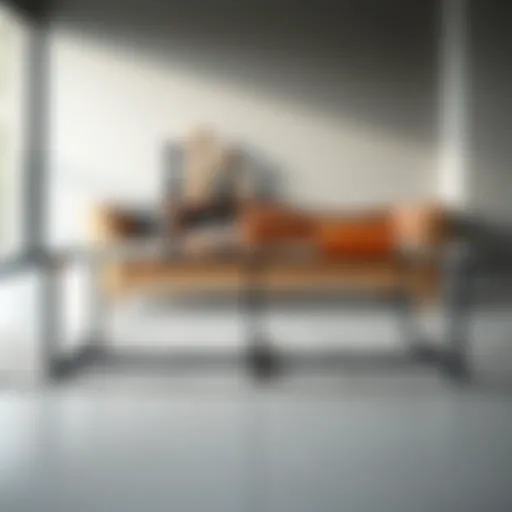The Definitive Guide to Bookcase Sets: Style and Function
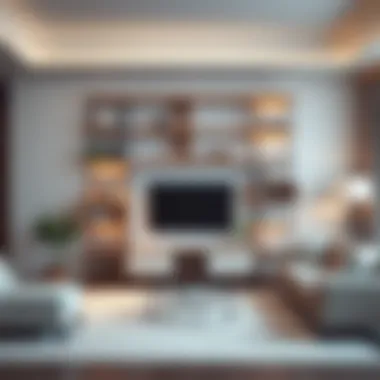
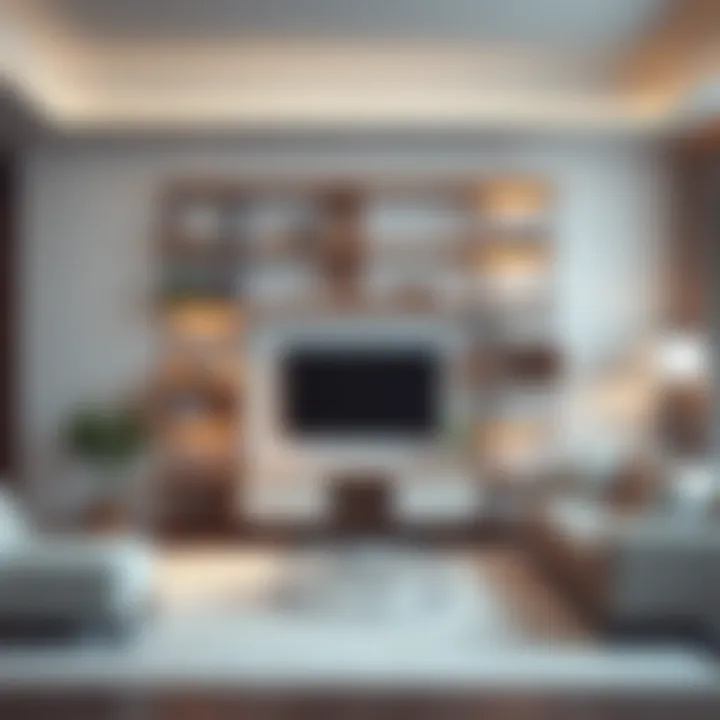
Intro
Bookcase sets are more than just furniture; they encapsulate the delicate balance between aesthetic appeal and functional design. When thoughtfully selected, these sets can not only enhance the visual charm of a room but also serve practical purposes like organizing books, displaying cherished memorabilia, or even acting as room dividers. Homeowners and interior designers alike find themselves drawn to the prospects that well-crafted bookcase sets offer. Understanding the trends, materials, and styles in this ever-evolving landscape helps individuals make informed decisions tailored to their unique spaces.
As we navigate through this comprehensive guide, we will uncover various design trends that are shaping contemporary interiors. We’ll explore materials that are innovative yet sustainable, highlighting how functionality aligns with environmental consciousness. This interplay adds layers of meaning to the simple act of choosing a bookcase. Let's delve into the depths of design trends, scrutinizing both the contemporary styles that are making waves today and the vintage inspirations that remind us of eras gone by.
Design Trends
When it comes to bookcase sets, design is not merely about aesthetics; it reflects broader cultural tendencies and individual preferences. An analysis of design trends reveals how personas and styles can coalesce into something that not only beautifies a room but also reflects its occupants’ identities.
Contemporary Styles
Current trends are greatly influenced by minimalism, where less is indeed more. Sleek lines and neutral tones dominate many contemporary bookcase designs, aiming for a sense of calm and order in living spaces. Open shelving has gained popularity, allowing items to breathe rather than be confined. It encourages the display of personal artifacts in a manner that feels intentional.
Wall-mounted bookcases are particularly favored in modern homes, as they help in maximizing floor space. The use of asymmetrical designs can lend a playful flair while emphasizing creativity. Homeowners today often wish to showcase their collections rather than hide them away behind closed doors. Therefore, the hybrid piece—where bookcases double as art installations—is increasingly common.
Vintage Inspirations
Nostalgia often pulls at the heartstrings, igniting interest in vintage-inspired bookcase designs. The allure of reclaimed wood, ornate moldings, and classic colors evoke a feeling of warmth that many seek in their homes. Mid-century modern styles, characterized by their organic shapes and vibrant hues, have made a formidable comeback.
Art Deco influences are also evident in current designs, employing rich materials and geometric patterns that invite admiration. These vintage styles often tell stories—each scratch or mark adding character and depth. Homeowners sometimes gravitate toward bookcases that not only hold books but also carry a narrative of their own, connecting past and present.
"Bookcases are not just storage; they are personal galleries that tell the world who we are."
With various options at hand, the question remains: how do homeowners and designers choose the right bookcase that aligns with their vision?
Material Innovations
Innovations in materials have led to remarkable advancements in the quality and sustainability of bookcase sets. As society grows increasingly aware of environmental issues, more conscientious choices are being made regarding furniture production and material sourcing.
Sustainable Materials
Eco-friendly options are now at the forefront, with many furniture manufacturers exploring sustainable timber and recycled materials. Designs that incorporate bamboo or reclaimed wood not only provide strength and durability but also cater to those yearning to minimize their ecological footprint.
Additionally, the use of non-toxic finishes and biodegradable adhesives is gaining traction, providing safer alternatives for households with children or pets. It’s not uncommon for modern bookcase designs to combine aesthetics with guilt-free, sustainable living principles.
Smart Furniture Technology
Technological advancements have also pervaded furniture design, guiding the future of bookcase sets. Items equipped with integrated charging ports or lighting functionalities are increasingly appealing to a tech-savvy audience. Smart bookcases that can be connected to home automation systems allow users to seamlessly integrate design with technology, creating a functional and interactive space.
Prelims to Bookcase Sets
Bookcase sets are not just mere furniture; they represent the intersection of utility and style, encapsulating a significant aspect of interior design. When discussing living spaces, bookcases can transform a simple room into a sanctuary of organization and creativity. This narrative aims to uncover the profound impact these sets have on our surroundings, illustrating how they combine functionality with aesthetic appeal.
Defining Bookcase Sets
Bookcase sets refer to groups or collections of shelving units designed to hold books and other display items. Unlike single bookcases, these sets usually come in matching or coordinated designs, offering a consistent look throughout a space. They vary in size, shape, and functionality, catering to diverse needs and tastes.
In terms of function, a bookcase set does more than stack volumes—it serves as a canvas for personality. An elegant wooden set can whisper sophistication, while a metal one might shout industrial chic. These pieces can also include cabinets, drawers, and adjustable shelves, maximizing storage potential.
The right bookcase set can anchor a room's design, drawing attention while enabling organization. Essentially, they are tools for crafting an inviting atmosphere, whether in a bustling family room or a serene reading nook.
Historical Context
The journey of bookcases is steeped in history, tracing back to ancient civilizations. The first forms emerged in ancient Egypt, where scribes stored scrolls on primitive shelves. Fast-forward to the Renaissance, and you’ll find beautifully crafted wooden bookcases that symbolized wealth and intellect. These pieces were often adorned with intricate carvings, making them stunning focal points in grand libraries.
In the 19th century, the evolution of bookcases continued with the introduction of mass production. This democratization allowed bookcase sets to become more accessible to the average homeowner, shifting from luxury items to essential furnishings in households. Today, they not only reflect personal style but also accommodate modern needs, such as compact designs for small apartments.
Through various eras, one thing remains clear: bookcases have always been more than just storage. They embody a culture of learning, showcasing not only books but also pictures, memorabilia, and unique artifacts that tell a story about the inhabitants. Whether it’s a classic wooden library filled with tomes of knowledge or a contemporary set flaunting modern art, these pieces continue to play an essential role in our homes.
The Multifunctionality of Bookcase Sets
Bookcase sets aren't just for storing volumes of unread literature; they represent an integral component of interior design and everyday functionality that meets diverse needs. The overlapping uses of these pieces extend beyond a mere repository for books, morphing spaces and lifestyles into organized, visually compelling areas. It’s no surprise that homeowners and design aficionados alike regard these furnishings as essential. Their importance lies in the effective blend of form, function, and flair, making them suitable for any living or working space.
Storage Solutions
At the crux of what makes bookcase sets indispensable is their innate ability to offer storage solutions. Often, space is at a premium in modern households. Bookcases can optimize room usage by providing vertical storage, which is especially useful in smaller areas. They help declutter while keeping frequently used items like books, decorative boxes, and even board games easily accessible.
Moreover, many bookcase designs come equipped with adjustable shelving, allowing homeowners to tailor the setup according to their needs. Some bookcases can even incorporate hidden compartments or drawers, which gives you the freedom to neatly stow away miscellaneous items without sacrificing aesthetic appeal.
- Vertical space utilization: Maximizes storage capacity.
- Adjustable shelves: Personalize the configuration based on changing storage needs.
- Built-in storage: Optimizes unused areas, often enhancing the room's overall design.
Display and Aesthetics
Beyond mere practicality, bookcase sets provide an opportunity for display and aesthetics. They serve as canvases for creative expression. Homeowners can carefully arrange books, photographs, or artwork, using the bookcase to convey a personal narrative. This not only transforms an ordinary wall into a statement feature but also shines a light on the homeowner's personality.
The impact of thoughtful display cannot be overstated. A well-curated bookcase can act as an eye-catching focal point in a room, enhancing the overall ambiance. Utilizing various decorative elements like plants, art pieces, or mementos alongside your collection can create depth and interest.
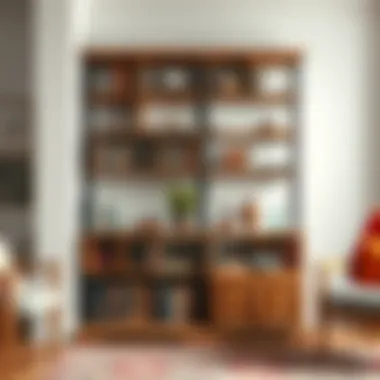
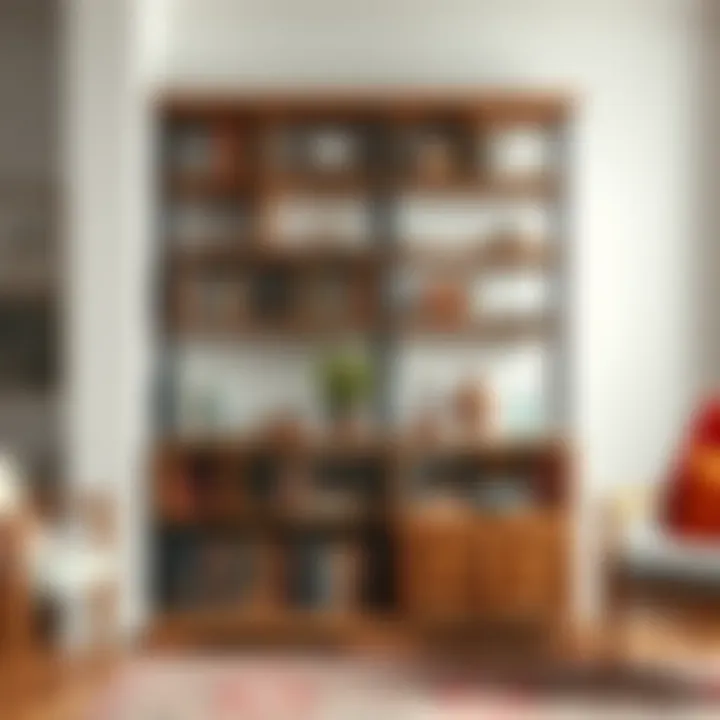
"A bookcase is not just furniture; it's a storytelling medium that reflects its owner's journey through words and experiences."
Room Division
In larger living spaces, bookcase sets can serve as tools for room division without the need for constructing permanent walls. Open-plan layouts are all the rage, and using bookcases creatively can delineate spaces for living, dining, or working. They provide a visual barrier while still allowing light to flow freely, which is essential for maintaining an open feel.
Additionally, a strategically placed bookcase can add a feeling of intimacy to a space, effectively creating cozy nooks where you can retreat with a book or engage in focused activities. This method of division showcases the versatility of bookcases — they are not merely static entities but dynamic facilitators of how we define and occupy our spaces.
In summary, the multifunctionality of bookcase sets extends far beyond their traditional role. By optimizing storage, enhancing aesthetics, and acting as room dividers, they cater to the needs of contemporary living. Understanding these facets can change how you perceive and implement bookcase sets in your own environment.
Exploring Different Styles
When it comes to bookcase sets, style is not just about aesthetics; it defines the essence of a room and influences the overall ambiance. Understanding different styles allows homeowners and interior designers to make informed decisions that reflect personal taste while also catering to functionality. Different styles can create distinct atmospheres, whether it’s a serene reading nook or an energizing workspace.
Modern Bookcase Designs
Modern bookcase designs often embrace minimalism and clean lines. A key characteristic is their simplicity, which can make a bold statement without overwhelming a space. Often, these bookcases employ materials like sleek metal and smooth wood, presenting an elegant blend of form and function.
These designs are versatile enough to fit into any contemporary setting, making them appealing for individuals looking to create a sophisticated presence in their homes. Also, contemporary designs might feature open shelving that allows for a creative display of books and decor, thereby transforming basic storage into an expressive gallery.
Classic Styles
Classic styles bring with them a rich history and a sense of tradition. These bookcases are typically crafted from solid wood and showcase intricate details such as molding and carvings. Styles like Federal or Victorian are steeped in tradition and serve as timeless focal points in any room.
Having a classic bookcase in your space is like adding a piece of art; it not only functions as storage but also tells a story. For many, these designs evoke nostalgia and comfort, aligning perfectly with a cozy reading corner or a study.
Rustic Inspirations
Rustic bookcase designs often draw inspiration from nature, emphasizing the beauty of raw materials like reclaimed wood. Characterized by a rugged look and weathered finish, these bookcases speak to a simpler way of life, encouraging warmth and familiarity.
This style is perfect for those who appreciate the outdoors and want to infuse their interior with natural elements. It invites a sense of tranquility, making it ideal for a cabin-like feel or a welcoming family room.
Industrial Looks
Industrial bookcase sets often reflect an urban aesthetic, merging function with a rugged edge. These designs use materials like steel and unfinished wood, creating an edgy, modern appeal that caters to a young, trendy demographic. The open-air structure facilitates easy access to stored items while enhancing airflow and light.
Perfect for lofts and converted spaces, industrial bookcases are practical and stylish, making a statement without needing to be overly decorated. They encourage creativity and can serve dual roles, acting as a divider in an open layout, while simultaneously showcasing books and decorative pieces.
Contemporary Twist
A contemporary twist combines elements from various styles, featuring innovative design concepts that challenge traditional norms. This approach can include asymmetrical shapes, bold colors, or unexpected materials, making these bookcases not just furniture, but interactive art.
Often, contemporary designs cater to the needs of modern living, incorporating features such as hidden storage or modular components. This flexibility allows homeowners to adapt their bookcase sets over time, fostering a dynamic living environment.
In summary, exploring different styles of bookcase sets can significantly enhance one’s living space and personal aesthetic. Each design style presents unique traits and benefits, offering multiple ways to elevate your home.
Material Considerations
When it comes to choosing bookcase sets, the material is a cornerstone factor in both functionality and aesthetic appeal. The material directly influences durability, maintenance, and integration into various design styles. A well-selected bookcase does not just act as a storage solution but also transforms a living space, serving as an extension of personal style.
While aesthetics may attract the eye, understanding the practical aspects of materials can make or break the longevity and effectiveness of the bookcase. Thus, diving into the nuances of material types is paramount for homeowners and designers alike.
Wood Types
Selecting the right wood for a bookcase can be likened to choosing the right foundation for a house—it's essential for sturdiness and character. Common wood types include oak, maple, and pine. Oak, well-known for its strength and grain, holds up well under heavy books and adds a touch of class. Maple, being lighter in color, allows more flexibility in design coordination. Pine, while softer and often more affordable, brings a rustic charm to spaces without breaking the bank.
Consider factors like the weight of your collection and the climate. For instance, in humid areas, certain woods may warp or bow. Ultimately, knowing the differences between hardwoods and softwoods aids in making informed choices that resonate with both practicality and style.
Metal Compositions
Metal bookcases are increasingly popular, especially in contemporary designs. They bring a sleek look that resonates well with minimalist arrangements. Materials like steel and aluminum offer remarkable strength and support, making them perfect for heavier items. However, they ultimately call for a discerning eye, as the finish can significantly affect aesthetics. Matte finishes tend to create a more industrial vibe, while polished metal elevates modern sophistication.
One consideration not to overlook is rust. A bookcase made of untreated metal in a high-humidity area can quickly develop complications. Therefore, seek options like powder-coated metal that minimizes the risk and maintains a clean appearance, while lasting longer. The blend of metal with other materials, like glass or wood, can create unique designs that are both striking and functional.
Glass Features
Glass elements, whether used in doors or shelves, add a touch of elegance and a light-enhancing quality that can open a room visually. The transparency of glass makes it an excellent choice for displaying collectibles or art books, turning the bookcase into a showcase rather than just a storage unit.
However, glass is not without its limitations. It can be fragile and requires careful placement. Tempered glass, which is much stronger than standard, is advisable if you want durability while maintaining transparency. The presence of glass can also necessitate more frequent cleaning to keep it looking pristine. For some, the lack of hidden storage might pose a challenge when it comes to clutter management. A clever compromise could involve a mix of glass and solid doors, marrying display with discretion.
Sustainable Options
With growing environmental concerns, sustainable materials have become a hot topic in furniture design. Choices such as reclaimed wood or bamboo are not only eco-friendly but offer unique textures and patterns that can't be replicated in new materials. Reclaimed pieces tell a story, bringing character and history into a home, which several buyers find immensely appealing.
Moreover, opting for sustainably sourced woods certified by bodies like the Forest Stewardship Council (FSC) ensures that your choices support responsible logging practices. In addition, many manufacturers are now utilizing recycled metals and plastics, reducing waste and offering durable products with a reduced carbon footprint.
By being conscious of material selection, homeowners can not only enhance their living spaces but also contribute positively to the environment, transforming bookcase sets into symbols of both style and responsibility.
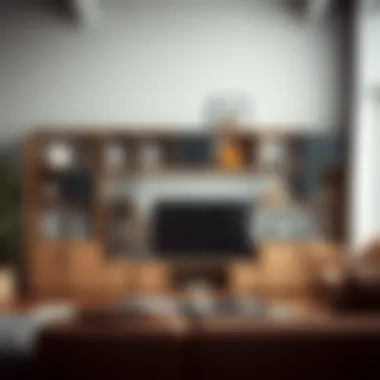
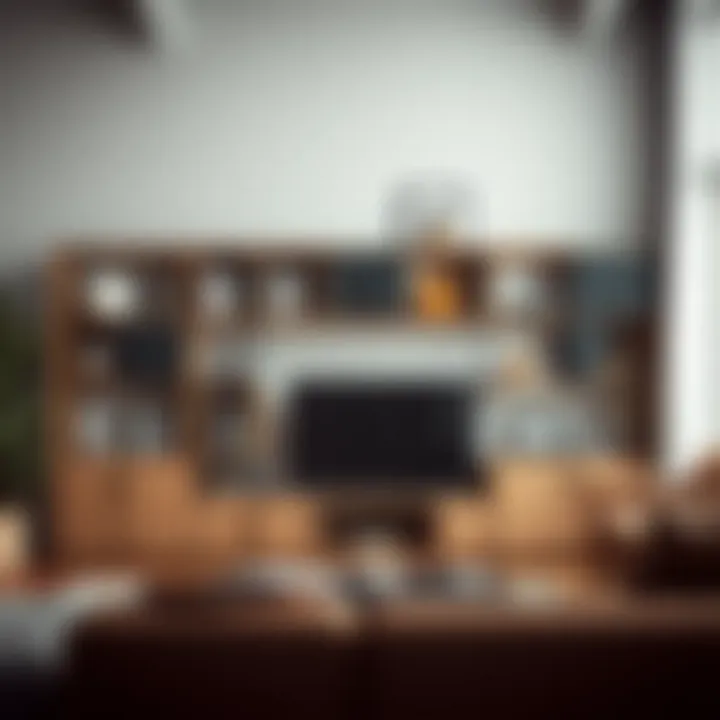
Designing with Bookcase Sets
When it comes to creating a harmonious and functional living space, the design of your bookcase sets plays an essential role. It's not merely about finding a place to stash your literary treasures; it's about crafting an environment that reflects your personal style and meets practical needs. Bookcases can serve as both functional storage solutions and eye-catching focal points within a room, thereby influencing the overall aesthetic and flow of your living area.
A well-designed bookcase set should complement your home’s interior while addressing specific requirements. This involves considering the size, placement, and color coordination of the bookcases.
Choosing the Right Size
Selecting the size of your bookcase is crucial. An oversized bookcase can overwhelm a small room, making it feel cluttered. On the other hand, a tiny bookcase in an expansive area can simply get lost in the space. To find the right size, measure the intended space and contemplate how you intend to utilize the bookcase. Shall it display a collection of well-loved novels, house decorative elements, or serve as a functional divider between two spaces?
Key considerations:
- Dimensions: Measure both height and width. Keep in mind that wall-mounted units can save floor space.
- Volume of items: Know the number of books you wish to store, as that will guide the number of shelves you might need.
- Proportion: Ensure that the bookcase's scale matches the furniture around it for an aesthetically pleasing look.
"A bookcase is not only a place for books; it can transform a room’s character and function."
Placement in Living Spaces
The placement of your bookcase is as vital as its size. Think about how the bookcase interacts with the rest of the room. Is it against a wall where it can draw the eye without obstructing pathways? Or perhaps it finds its home as a room divider? Each choice alters how the space feels.
Common placement options include:
- Against a wall: This is a traditional method that maximizes space and offers a clean backdrop for your decor.
- In a corner: L-shape designs can fit snugly in corners to minimize wasted space.
- Floating units: Wall-mounted bookcases lend a modern touch while creating an illusion of space.
When considering placement, take into account lighting sources. Natural or artificial light can affect how people perceive the area around the bookcase, making it an inviting or dark space.
Color Coordination
Color can make or break the design appeal of a room. When choosing a bookcase set, ensure the colors enhance the surrounding decor. This doesn’t mean you have to match everything perfectly, but rather complement the existing atmosphere.
Color considerations:
- Neutral tones: Shades like whites, grays, or beiges can create a serene backdrop.
- Bold colors: Deep blues or forest greens can add drama, standing out while fitting in.
- Wood finishes: Different wood types come with unique palettes; cherry and oak present warm hues while ash offers a cooler tone.
Incorporate accents that resonate with your personal style, whether that be through decorative items on the shelf or the arrangement of books themselves. Play with these elements to achieve an organized, yet personalized aesthetic.
By carefully considering size, placement, and color, you empower yourself to design with bookcase sets that not only serve their purpose but also resonate with your lifestyle and home’s character.
Trends in Bookcase Sets
Understanding the trends in bookcase sets is crucial for anyone interested in interior design and functionality. These trends not only reflect current aesthetic preferences but also highlight evolving consumer needs and societal changes. As the lines between living, working, and leisure spaces blur, bookcase sets become vital elements in how we curate our environments. Today’s home is not just a place to live; it symbolizes personal identity and functional versatility. Thus, staying abreast of trends can aid in making informed decisions that enhance both style and utility.
Minimalist Trends
Minimalism has gained a strong foothold in modern design, resonating with those who value simplicity and functionality. Bookcase sets designed with a minimalist approach often feature clean lines, uncluttered surfaces, and a focus on natural materials. For instance, a streamlined oak bookcase might serve as both a storage solution and a subtle art piece, allowing books and decorative items to shine without overwhelming the senses.
The benefits of minimalist trends include:
- Increased Space Perception: Simple designs can make even smaller rooms feel more open and airy.
- Focus on Essentials: By minimizing the number of items on display, one can emphasize quality over quantity.
- Ease of Maintenance: Fewer items and simpler structures mean less dusting and cleaning.
This trend invites individuals to contemplate their collections, leading to a more curated, meaningful home environment.
Maximalist Approaches
In stark contrast, maximalism embraces boldness and exuberance. This trend sees bookcase sets adorned with vibrant colors, intricate patterns, and an impressive array of decor items. Think of a bookcase that incorporates vintage trinkets alongside modern art and family photos, creating a dynamic narrative that reflects a rich life story.
Maximalist design encourages:
- Personal Expression: There are no strict rules, allowing for creativity and individuality.
- Visual Interest: A well-decorated bookcase can act as a focal point in any room, sparking conversations and admiration.
- Cultural Narratives: This approach often incorporates diverse influences, showcasing an appreciation for various backgrounds and histories.
Exploring maximalism can lead to unique, layered spaces where each item finds its voice among a chorus of color and texture.
Color Pop Innovations
Adding a splash of color to bookcase sets is one of the most intriguing trends observed recently. The idea of integrating bright hues not just in decor but also in the actual design of the bookcase has emerged as a refreshing twist. Whether it’s painted bookshelves in a vibrant teal against a neutral wall or pastel hues in child-friendly spaces, color pop innovations breathe life into traditionally mundane furniture.
Some notable advantages of using color in your bookcase sets include:
- Mood Enhancement: Colors can profoundly influence emotions. Warm colors can energize, while cool tones can create a serene atmosphere.
- Personalization: Choosing specific colors allows individuals to inject their own style flair into their interiors.
- Trend Adoption: Embracing bold colors can often align with seasonal trends, making your design feel fresh and current.
Incorporating these colors carefully ensures that your bookcase is not only functional but also visually compelling, becoming an integral part of the room’s personality.
"Trends in bookcase designs tell us more about our values and identities than we might expect, combining style with a reflection of who we are."
Overall, keeping track of these trends helps homeowners, designers, and decorators not just in aesthetic appeal but in optimizing functionality and personal expression in their spaces.
Cultural Significance of Bookcases
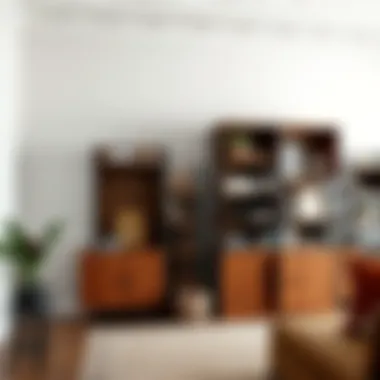
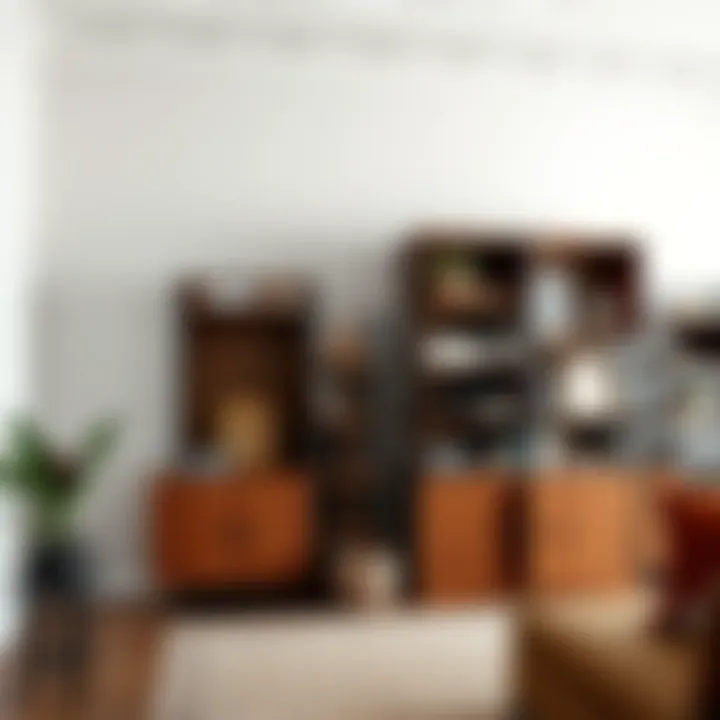
Understanding the cultural significance of bookcases is akin to holding up a mirror to human civilization itself. These pieces of furniture do not merely serve as storage spots for tomes and knickknacks; they embody the values, aspirations, and historical narratives of various societies. Examining bookcases through this lens reveals their profound impact on both our interior spaces and our cultural consciousness.
Bookcases in Literature and Art
Throughout time, bookcases have appeared in countless literary works and art pieces, symbolizing knowledge, wisdom, and sophistication. From the globe-filled libraries in classical stories to the minimalistic shelves in modern poetry, the imagery associated with these structures tells a story of intellectual pursuit. For instance, take the iconic scene in Fahrenheit 451 by Ray Bradbury where the protagonist's rebellion against censorship involves the preservation of books—what better symbol to represent this than a bookcase brimming with defiance?
In visual arts, artists like Jean-Auguste-Dominique Ingres have depicted scholars surrounded by bookcases, underscoring the idea that knowledge is both a refuge and a source of power. These representations could be seen as a reflection of cultural reverence for learning, elevating bookcases to an almost sacred status within artistic narratives. Indeed, a bookcase can be viewed as the stage where these narratives unfold, linking its physical presence to the intangible essence of literature and creativity.
Cultural Reflection Through Design
Bookcases are also shaped by cultural values and design trends of their times. They can narrate tales of progress, tradition, and identity. For example, the Victorian era brought forth elaborate cabinets reflecting industrial advancements, while modern minimalism showcases clean lines and functionality—mirroring a shift towards practicality and simplicity in lifestyle.
Different cultures have their own influences on bookcase design. In Scandinavian homes, simple wooden shelves serve not just as functional pieces but as elements harmonizing the overall aesthetic of the space. Similarly, Japanese bookcases may seamlessly incorporate traditional elements like sliding doors, connecting the past with modern lives. Such design choices are no accident; they echo deep-seated beliefs and practices, making bookcases a lens through which one can explore cultural narratives.
"Bookcases are not merely storage; they are a window into the soul of a society, reflecting its values, aspirations, and creative expressions."
In summary, the cultural significance of bookcases is vast and multi-faceted. They serve as vessels of literature and art, symbolize human aspirations toward knowledge, and reflect the evolving design ideals of varying societies. Homeowners and designers alike can draw from this rich history, allowing bookcases to be more than just functional components in homes. Instead, by thoughtfully integrating bookcase sets into living or working spaces, one can create atmospheres that resonate with both personal identity and broader cultural narratives.
For further reading on the intersection of culture and design, you might want to explore resources at Britannica or delve into discussions on cultural reflections on platforms like Reddit.
The Future of Bookcase Sets
As we look toward the horizon, it's easy to see that bookcase sets are not just a fixture of the past but a pivotal part of a modern home’s design narrative. They marry functionality with artistic expression. As society shifts toward a more integrated and tech-savvy way of living, the evolution of bookcase sets reflects a broader transformation in how spaces are used. These functional pieces must not only serve the traditional role of storing books and collectibles but also adapt to emerging design trends and technological advancements.
Technological Integration
The future of bookcase sets is heavily intertwined with technology. Home automation systems are making their way into spaces where bookcases are being used, changing the functionality and aesthetics. Imagine a bookcase that not only holds your beloved tomes but also features built-in LED lighting that adjusts to the time of day or your mood. This integration doesn’t stop with lighting; technology like smart shelves can be employed, which is capable of sensing weight to display remaining shelf life for items stored.
Incorporating audio systems, like embedded speakers that blend into the structure, is becoming more common too. Smart home hubs hidden within a bookcase make controlling your environment a more seamless experience. Along these lines, some bookcases are being designed with wireless charging points and cable management systems, tackling clutter while keeping your gadgets powered.
“As technology continues to evolve, so too will the utility and design of the everyday bookcase, transforming it from a mere storage solution to a multifunctional home feature.”
Evolving Consumer Preferences
The preferences of consumers are on a rollercoaster ride at present, influenced by social trends, environmental considerations, and personal lifestyles. There's been a palpable shift towards sustainability, and this is shaping how bookcase sets are produced and what materials are selected. Homeowners are leaning toward eco-friendly options, seeking out bookcases made from reclaimed wood or responsibly-sourced materials. This not only reflects a concern for the environment but also adds a unique story to every piece.
Additionally, customization has become a critical aspect of buying trends. Today's consumers want products that can reflect their individual styles. Options that offer a range of colors, sizes, and modular configurations are becoming increasingly sought after. Unlike the old days when a bookcase was a standard, one-size-fits-all commodity, now, it’s essential to deliver tailored experiences.
Finally, with more people working from home, there’s been a surge of interest in creating functional office spaces that incorporate bookcases. People are looking for pieces that not only look good but also serve specific needs, like shelving that can accommodate both books and office supplies, making them an integral part of functional design.
In summary, the future of bookcase sets is bright and multifaceted. By embracing technologically integrated solutions and adapting to evolving consumer preferences, bookcase sets will not only adapt to trends but also dictate the design of living spaces to come.
Maintenance and Care
Maintaining and caring for your bookcase set is not just about keeping it looking pretty; it's about ensuring its longevity and functionality. These pieces are often the backbone of a room, providing both a useful storage solution and a display area for books, decor, or personal treasures. If you neglect proper care, you might end up with a less attractive focal point, or worse, damage that could shorten its lifespan. Regular maintenance keeps your bookcase set in tip-top shape and enhances the overall appeal of your living space.
Cleaning Techniques
Dusting and Wiping
Keeping your bookcase clean is a fundamental aspect of maintenance. Dust accumulates quickly, especially on shelves housing books or decorative items. Using a microfiber cloth is a great start. This material traps dust without scratching surfaces. Be sure to reach all nooks and crannies, as dust loves to hide there. For stubborn spots, a mix of mild soap and water does the trick. Do not soak the cloth—just a damp one will do. For wood bookcases, consider using a wood polish occasionally. This not just cleans but also helps nourish the wood, giving it a nice sheen.
Vacuum with Care
Sometimes, the best tool is a vacuum with a soft brush attachment. This helps to collect dust from higher shelves without needing a stool. But take care around the corners. Over time, these spots can accumulate debris you might not see otherwise. Make sure your vacuum is free of sharp edges to prevent any unintentional scratches.
Handle with Caution
Be mindful of how you handle books and objects when cleaning. Always lift items rather than sliding them off the shelf. This reduces the risk of scratching or damaging the bookcase surface. Also, avoid using harsh cleaners; they can strip finishes, making the wood look worn. Instead, stick to gentle products that won't disrupt the integrity of your furniture.
Repairing Minor Damages
Even with the best care, wear and tear can happen. Scratches and dents can diminish the beauty of your bookcase set. Luckily, minor damages can often be repaired at home without needing to call in a professional.
Wood Scratches
For small scratches in wood, a simple hack involves using a walnut. Rubbing the meat of the walnut over the scratch fills in gaps with natural oils. It’s an old-school trick that works wonders. Additionally, you can use a marker that matches the color of your wood. Just apply it carefully and let it dry. For slightly deeper scratches, a filler wax can be used to fill in the groove before polishing.
Dents
For dents, particularly in wood, you can use a damp cloth and an iron. Place the damp cloth over the dent, apply the iron for a couple of seconds, and the heat will help expand the wood fibers back into place. Just be cautious not to burn the wood; it’s a delicate balance and may take a few tries.
Re-staining or Touch-ups
If a section of your bookcase has lost its color, consider doing a touch-up with stain. Just make sure to test it in an inconspicuous area first. This way, you prevent any color mishaps that might stand out once applied. If your bookcase has suffered a significant scratch or alignment issue, tools like wood glue or clamps can help repair it without needing full replacement.
Keeping your bookcase sets in prime condition not only preserves their beauty but also enhances their functionality, ensuring they remain a treasured part of your space for years to come.
With a little effort, your bookcase set can continue to be a statement piece in your home. Regular cleaning and minor repairs make a world of difference and contribute to a cohesive and well-maintained living environment. By investing time in maintenance, you're effectively retaining not only the physical integrity of your bookcase but, more importantly, its value and significance in your space.
The End
As we wrap up our exploration of bookcase sets, it’s crucial to reflect on their multifaceted nature and the significant part they play in both form and function within our spaces. These pieces aren't just about storage; they're about defining a room's character, organizing thoughts in a physical form, and manifesting personal style. When considering bookcase sets, keep in mind the blend of aesthetics and utility they offer. A carefully selected set can elevate your home or office while also providing a structured environment for your literary treasures and decorative items.
Recap of Key Points
To sum it all up, here are the pivotal takeaways from this guide:
- Versatility: Bookcase sets serve a variety of roles—storage, display, and even as functional dividers.
- Current Trends: From minimalist to maximalist designs, the trends are continually evolving, reflecting broader cultural shifts and personal styles.
- Material Choices: The selection of materials like wood, metal, and glass impacts aesthetics as well as durability and eco-friendliness.
- Design Considerations: Proper sizing, placement, and color coordination are key to integrating bookcases into your interiors harmoniously.
Understanding these points will not only help in selecting the right bookcase set but also ensure it enhances your space effectively.
Final Thoughts on Bookcase Sets
"A room without books is like a body without a soul." - Marcus Tullius Cicero
For further insights on interior design and decor, you may want to explore resources such as Wikipedia and Britannica for deeper dives into the cultural implications of design choices.





